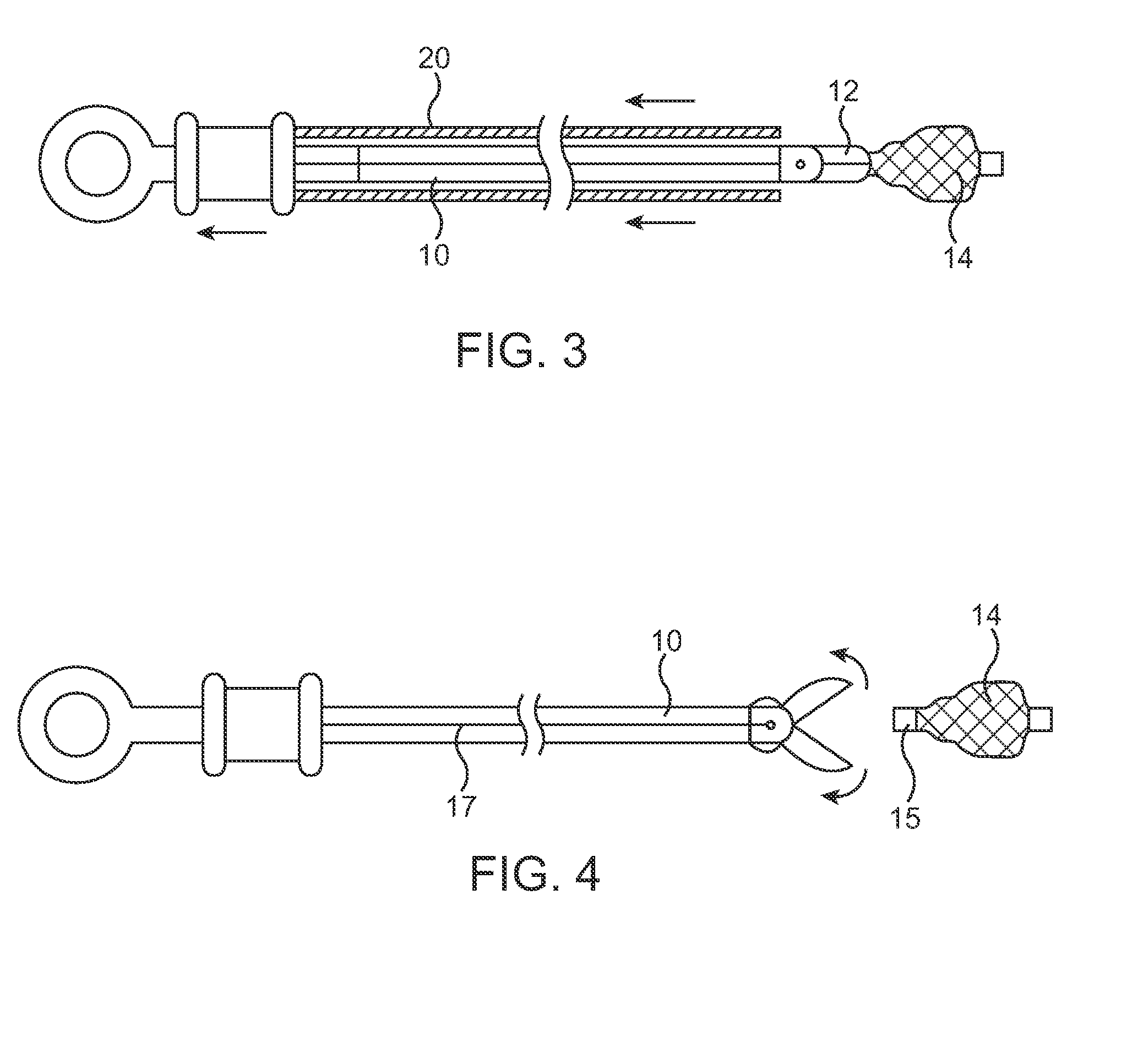Systems and methods for delivering flow restrictive element to airway in lungs
a technology of flow restriction and airway, applied in the field of medicine, can solve the problems of extended procedure time and frustration for operators, inability to retrieve inaccurately placed stents within acceptable procedural time limits, and inability to perform catheter-based therapeutic procedures
- Summary
- Abstract
- Description
- Claims
- Application Information
AI Technical Summary
Benefits of technology
Problems solved by technology
Method used
Image
Examples
first embodiment
[0061]FIG. 4A describes an alternative configuration of the release mechanism. The modified graspers or biopsy forceps 10 used in the first embodiment can also have an additional mechanism in the proximal end that biases the jaws to be in the open position. A pull wire 17 of the graspers is designed to be “pull to close”. A piston 22 is fixed to wire 17 and combined with a compression spring 24 or a “jaw opening spring” maintains a “push” force on the wire. This type of loading forces the jaws to open when unconstrained. The loading can be low enough that the outer sheath 20 constrains the jaws 12 to the closed position but high enough to allow the jaws 12 to open freely when unsheathed. This greatly simplifies the hand manipulations required of the operator because the steps to unsheathe the stent will also unsheathe the jaws. It allows for a more intuitive and automated release of the stent. FIG. 4A also shows the actuation barrel 26 of the proximal handle housing a final release ...
third embodiment
[0065]FIG. 9 describes this invention. A loop snare 50 is formed from a wire or string and is configured to snare the stent 14. A proximal end 52 of the wire or string is attached to an actuator handle 54 that enables remote tightening or loosening of the snare on the stent. FIG. 10 illustrates the loop 50 of the distal end of the wire or string in detail. The loop is configured in such a way that allows for tightening of the snare when placed in tension and loosening of the snare when tension is released and / or compression is placed on it. One means of accomplishing this is to place an eyelet 51 at the end of the wire or string and then to run the other end of the wire or string through the eyelet. Pulling on the wire or string tightens the snare and releasing or pushing the wire or string loosens the snare. The loop 50 snaring a proximal end of the stent 14 is shown in FIGS. 11A and 11B. The loop tightens down on the proximal end of the stent snaring it. This action maintains a ho...
fourth embodiment
[0070]FIGS. 17A-17C describes three different keying configurations that can be used for this invention. One configuration has a center round hole with rounded slots at the 90 degree position and the 270 degree position (FIG. 17A). The next configuration has a more elliptical or oval shape (FIG. 17B). The last configuration shown has a center round hole with square slots at the 90 degree position and the 270 degree position (FIG. 17C). Each of these configurations operates similarly in that a hole of these shapes will accept a smaller rod of these shapes. A 90 degree rotation of the rod with respect to the hole will engage the two components and provide an interference. This interference allows the two components to stay attached. Just as a 90 degree rotation allows the two components to engage, another 90 degree rotation allows the two components to disengage. Disengagement can occur when the longer features located at 90 degrees and 270 degrees are aligned with respect to the two ...
PUM
 Login to View More
Login to View More Abstract
Description
Claims
Application Information
 Login to View More
Login to View More - R&D
- Intellectual Property
- Life Sciences
- Materials
- Tech Scout
- Unparalleled Data Quality
- Higher Quality Content
- 60% Fewer Hallucinations
Browse by: Latest US Patents, China's latest patents, Technical Efficacy Thesaurus, Application Domain, Technology Topic, Popular Technical Reports.
© 2025 PatSnap. All rights reserved.Legal|Privacy policy|Modern Slavery Act Transparency Statement|Sitemap|About US| Contact US: help@patsnap.com



